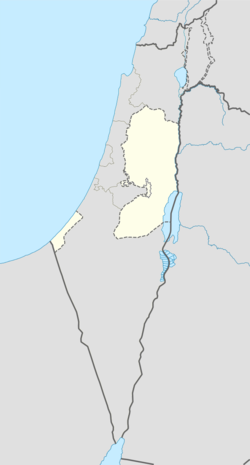Top Qs
Timeline
Chat
Perspective
Al-Funduq
Municipality type D in Qalqilya, State of Palestine From Wikipedia, the free encyclopedia
Remove ads
Al-Funduq (Arabic: الفندق) is a Palestinian village in the Qalqilya Governorate of the State of Palestine, in the northeastern West Bank, located east of Qalqilya.[3] According to the Palestinian Central Bureau of Statistics, the village had a population of 1,125 in 2017.[4] The village took its name from an Arabic word for "inn."[2]
Remove ads
In 2012, Jinsafut and Al-Funduq merged under one local council.[1]
Remove ads
Location
Al-Funduq is located 16 kilometers (9.9 mi) east of Qalqiliya. It is bordered by Immatain to the east, Deir Istiya to the south, Wadi Qana (in Salfit Governorate) to the west and Hajja to the north.[1]
History
Summarize
Perspective
Byzantine period
Ceramics from the Byzantine era were found here,[5] and it has been suggested that this place was Fondeka, once inhabited by Samaritans.[6][7]
Crusader period
During the Crusader period Funduq was inhabited by Muslims, according to the historian Diya al-Din al-Maqdisi. A Hanbali scholar named Ahmad ibn Abd al-Daim al-Maqaddasi al-Hanbali was born in the village in 575 AH/1180 CE. He died there in 668 AH/March 1270 CE.[8][9] Followers of the Hanbali scholar Ibn Qudamah (1146/47-1223) also lived in the village.[10] A Muslim sheikh named Abd Allah was another resident.[11][12]
Ottoman period
The place appeared in 1596 Ottoman tax registers as Funduq. It was in the Nahiya of Bani Sa'b of the Liwa of Nablus and had a population of 86 households, all Muslim, who paid a fixed tax-rate of 33.3% on wheat, barley, summer crops, olives, goats, beehives, and a press for olives or grapes, in addition to occasional revenue - a total of 10,500 akçe.[13]
A map from Napoleon's invasion of 1799 by Pierre Jacotin calls it Fondouk, a village by the road from Jaffa to Nablus.[14]
In 1838 Robinson described el-Funduk as a village in Beni Sa'ab district, west of Nablus.[15]
In 1870/1871 (1288 AH), an Ottoman census listed the village in the nahiya (sub-district) of Bani Sa'b.[16]
In 1882, the PEF's Survey of Western Palestine described the village as "a small poor village by the main road, with wells to the north and two sacred places; it stands on high ground," and located in the Beni Sab district.[7]
British Mandate
In the 1922 census of Palestine conducted by the British Mandate authorities, Funduq had a population of 66 inhabitants, all Muslims,[17] increasing in the 1931 census to 72 Muslims, with 21 houses.[18]
In the 1945 census El Funduq had a population was 100 Muslims,[19] with 1,619 dunams of land, according to an official land and population survey.[20] Of this, 43 dunams were for plantations or irrigated land, 1,026 for cereals,[21] while 14 dunams were built-up (urban) land.[22]
Jordanian period
In the wake of the 1948 Arab–Israeli War, and after the 1949 Armistice Agreements, Al-Funduq came under Jordanian rule.
The Jordanian census of 1961 found 137 inhabitants in Al-Funduq.[23]
Post-1967
Since the Six-Day War in 1967, Al-Funduq has been under Israeli occupation.
After the 1995 accords, 4.8% of Jinsafut and Al-Funduq land was classified as Area B, the remaining 95.2% as Area C.[24]
Remove ads
Demography
Local origins
Al-Funduq's residents originally came from Jab'it, near Duma. The village also absorbed refugees from Kafr Qara.[25]
References
Bibliography
External links
Wikiwand - on
Seamless Wikipedia browsing. On steroids.
Remove ads


